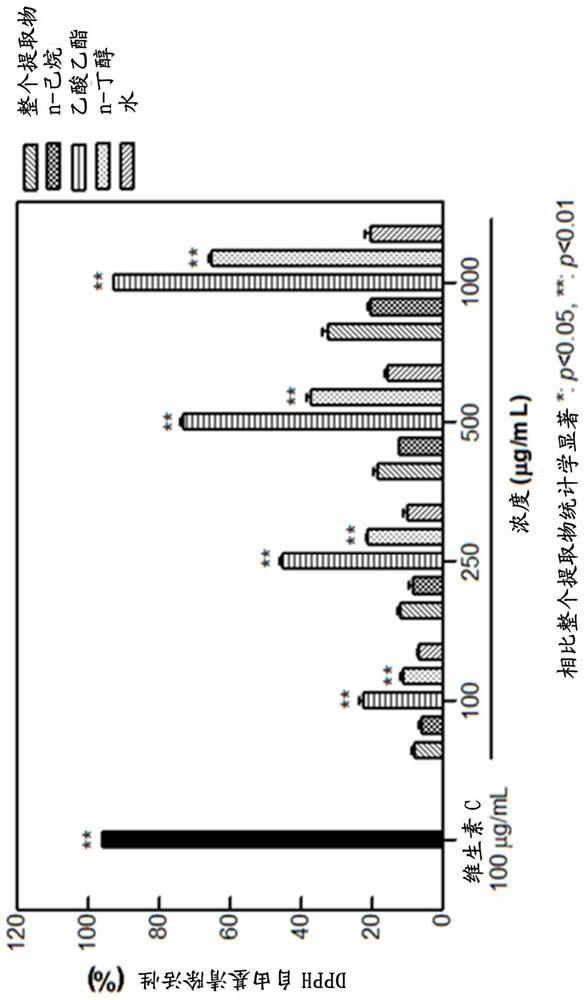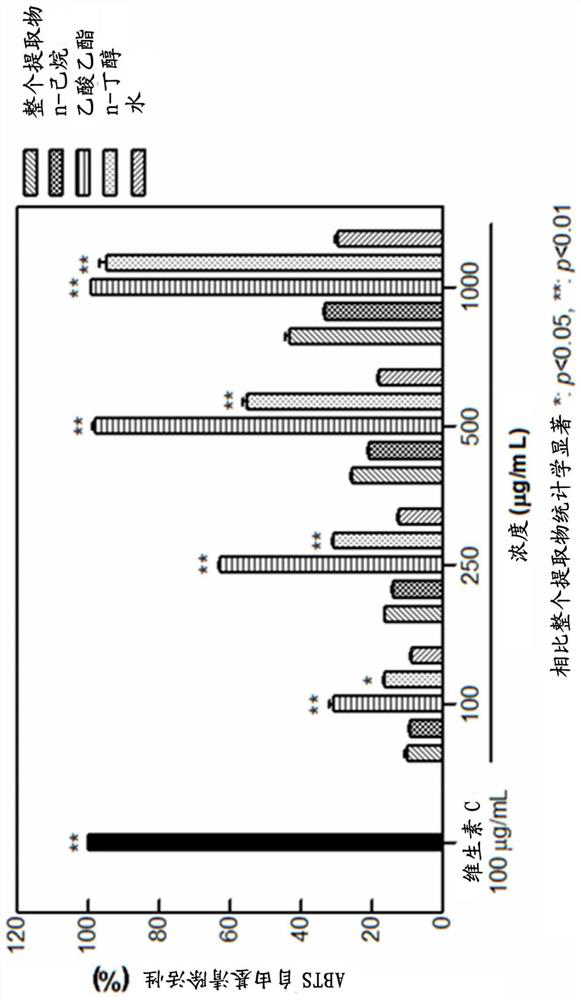Composition for antioxidation, anti-inflammation, or osteoclast differentiation inhibition
A composition and anti-oxidation technology, applied in the functions of food ingredients, medical preparations containing active ingredients, applications, etc., can solve problems such as effective research or reporting of osteoclast differentiation inhibition ability
- Summary
- Abstract
- Description
- Claims
- Application Information
AI Technical Summary
Problems solved by technology
Method used
Image
Examples
Embodiment 1
[0055] Example 1: Preparation of compound hot water extracts of Baishouwu, Han Dieshuan, and Korean Angelica
[0056] 125g of Baishouwu, 125g of Hanxuan and 135g of After the Angelica sinensis, it was extracted by refluxing hot water for 8 hours with water corresponding to 10 times (w / v, 1 / 10) the weight of the mixed crude drug. After that, the filtered filtrate was concentrated under reduced pressure to 20 to 40 brix by using an ultrafiltration membrane with a molecular weight cut-off of 10 μm, and then freeze-dried to obtain 172 g of Baishouwu, Han Dieshuan, and Korean Angelica in powder form. Complex hot water extract.
Embodiment 2
[0057]Embodiment 2: Preparation of water and organic solvent fractions
[0058] 2-1. Hexane fraction
[0059] 100g of the compound hot water extracts of Radix Polygoni Multiflori, Han Diessus, and Angelica sinensis prepared in the above steps were completely suspended in 500mL of water, and 500mL of hexane was added to repeatedly extract 4 times, and the hexane fraction was collected and passed through The solvent was completely removed by concentration under reduced pressure to obtain 0.5 g of a hexane fraction.
[0060] 2-2. Ethyl acetate fraction
[0061] After repeating extraction four times by adding 500 mL of ethyl acetate to the remaining layer (lower layer) except for the hexane fraction in 2-1 above, the ethyl acetate fraction was collected and concentrated under reduced pressure to completely remove the solvent to obtain 3.2 g of ethyl acetate fractions were obtained.
[0062] 2-3. Butanol fraction
[0063] After adding 500 mL of butanol to the remaining layer (l...
Embodiment 3
[0066] Example 3: Determination of 1,1-diphenyl-2-picrylhydrazine free radical scavenging activity
[0067] The antioxidant activity of radical scavenging ability was measured by confirming the ability to reduce or neutralize 1,1-diphenyl-2-picrylhydrazine group as a radical, that is, the oxidation inhibitory activity. 1, 1-diphenyl-2-picrylhydrazine is a relatively stable free radical in deep purple, which is reduced and decolorized by the sample, so it is used to measure the antioxidant activity. Specifically, 180 μl of 100 μM 1,1-diphenyl-2-picrylhydrazine solution was added to 20 μl of complex hot water extracts and fractions of Radix Polygoni Multiflori, Dipseuthes sativa, and Angelica sinensis, and reacted in dark vision for 30 Absorbance was measured at 517 nm after 1 minute, thereby confirming the concentration-dependent 1,1-diphenyl-2-picrylhydrazyl radical scavenging ability. Vitamin C was used as a positive control comparison substance, and the radical scavenging a...
PUM
 Login to View More
Login to View More Abstract
Description
Claims
Application Information
 Login to View More
Login to View More - R&D Engineer
- R&D Manager
- IP Professional
- Industry Leading Data Capabilities
- Powerful AI technology
- Patent DNA Extraction
Browse by: Latest US Patents, China's latest patents, Technical Efficacy Thesaurus, Application Domain, Technology Topic, Popular Technical Reports.
© 2024 PatSnap. All rights reserved.Legal|Privacy policy|Modern Slavery Act Transparency Statement|Sitemap|About US| Contact US: help@patsnap.com










